Classifying the Giant Pacific Octopus
Domain: Eukarya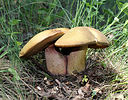
This domain is comprised of organisms that have a true nucleus. The
nucleus contains the genetic material, which is made up of DNA. Each
cell also contains membrane bound organelles, such as the mitochondria
or chloroplast. This domain includes plants, animals, protists, and fungi.

Kingdom: Animalia
Organisms in the kingdom Animalia are all heterotrophic. They are
unable to produce their own food and must feed upon other organisms. Animalia are multicellular. They can produce sexually and are
motile. This group contains animals all the way from sponges, to
invertebrates, to
humans. Other organism websites about animals include: the
sea sponge, the
panther, the
polar bear, and the
orangutan.
Phylum: Molluska
Mollusks have bilateral symmetry and a soft body, which is
frequently inside of a hard calcium carbonate shell. They have a
nervous system, circulatory system, gills, and a pair of kidneys.
This group includes:
the amber glass snail,
the magician's cone snail,
the eightfold pinecone (a type of snail),
zebra mussels, squid, and clams, to name only a few.
Class: Cephalopoda

“Cephalopod” translates to “head foot.” These organisms have a
closed circulatory system. They have flexible arms and a siphon.
Cephalopods even have a large brain with ganglia located inside of a
cranium. If there is a shell present, it is divided by septa. Other
members of the Cephalopoda include: the squid, nautilus, and
cuttlefish.
Subclass: Coleoidea
These cephalopods have an internal shell which is greatly reduced in
size or is nonexistent.
Squid
and other octopuses are also included in this grouping.
Order: Octopoda
Octopodes have eight arms,
hence the name “octo-poda,” which literally translates to “eight
feet.” They also have a rounded body without a shell.
Suborder: Incirrata
This group of octopodes do not have fins, unlike the members of the
alternative
suborder, Cirrata.
Family: Octopodidae
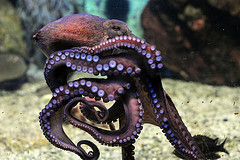
Organisms in this family have suckers which are in groupings of one
or two. They have a stomach and caecum that follow a digestive
gland. If they have lateral teeth on their radulas, the teeth have
only one cusp. The males of this group have a modified third arm into a
hectocotylus. Their hectocotylus is not detachable. This group
includes all of the classic
octopuses that even children can imagine, including the common octopus:
Octopus vulgaris.
Genus: Enteroctopus
The members of this genus are known as
“giant octopuses.” They have large bodies with longitudinal wrinkles
or folds. Giant octopuses’ heads are narrower than the width of
their bodies. They also have paddle-like shaped papillae instead of
the rounder v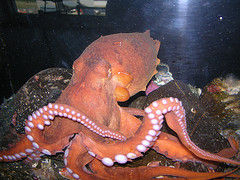 ersion found in other genera. Enteroctopus
megalocyathus and Enteroctopus magnificus are a couple
of the giant octopuses closely related to E. dofleini.
ersion found in other genera. Enteroctopus
megalocyathus and Enteroctopus magnificus are a couple
of the giant octopuses closely related to E. dofleini.
Species: Enteroctopus dofleini
Enteroctopus dofleini is the
specific scientific name of the organism this entire website is
devoted to. There are many characteristics that make it unique. Keep
reading to learn more.
Enteroctopus dofleini Phylogenetic Trees
The Pacific octopus was
recently re-classified. Previously, it was named Octopus
dofleini. But, it has been moved into the new genus,
Enteroctopus, along with all of the other giant octopuses of
the world.
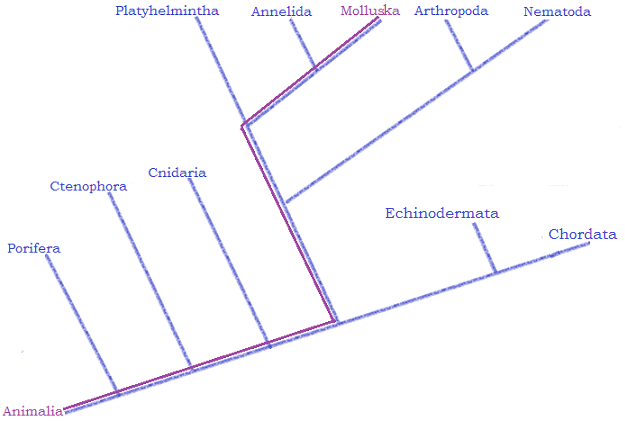
This image depicts the relationship between all of kingdom
Animalia's phyla. It shows
how E. dofleini travels from kingdom Animalia to phylum
Molluska via the purple line. This tree uses cladistic method of classification
to arrange the branching of the phyla depicted above. The cladistic
method means that they are arranged based on their molecular data,
or DNA genotype. This phylogenetic tree shows this organism
evolves farther away from the Porifera, or sponges, and toward the
Chordata, or humans.
The octopus has evolved away from the tissue-less
asymmetrical body style, and toward the endoskeleton with bilateral
symmetry style. However, the octopus is still an invertebrate. This
characteristic becomes clear when one realizes that this organism is
still quite far away from the phylum Chordata, and that all phyla to
the left of phylum Echinodermata are invertebrates. E. dofleini
does, though, display the evolutionarily-advanced characteristic of
bilateral symmetry.
Phylum Molluska's closest relative phylum is
Annelida. Phylum Platyhelmintha are also close relatives of the
mollusks. These three phyla are said to be closest related since
they all branch off of the same line. In conjunction, Arthropoda and
Nematoda are quite close relatives of these three phyla, too.
Alternatively, a great example
of convergent evolution compares the Pacific octopuses’
eyes with humans’. It is a great
depiction of convergent evolution because both species' eyes turned
out very similar, yet neither of them were passed down from a common
ancestor. This means that each species evolved their own style of
eye, while both species were existing at the same time. Yet, the
eyes miraculously ended up being extremely similar in both anatomy
and physiology. Since no other phyla between Chordata and Molluska
have creatures with camera eyes, this characteristic can be labeled
as a polyphyletic characteristic that connects the two, very
different, species.
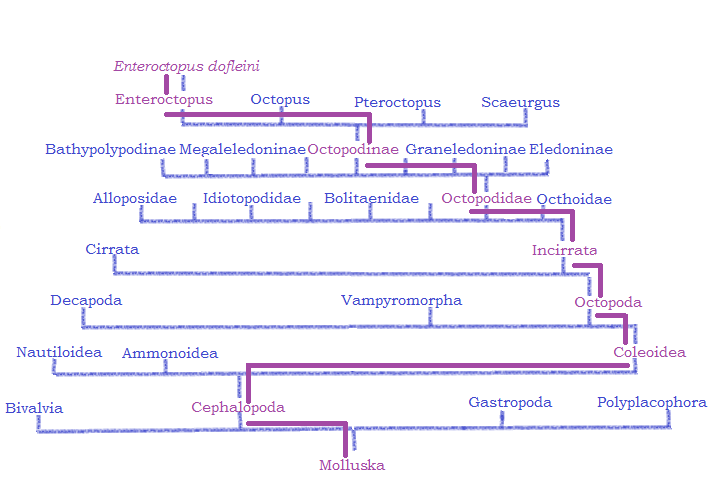
In
this tree, E. dofleini is followed from phylum Molluska all
the way to the the genus Enteroctopus. This tree also uses
a cladistic approach. It can be easily viewed in the way that the
subclass Coleoidea are very separated from the close-relating
subclasses of Nautiloidea and Ammonoidea. At this particular part of
the tree, the Pacific octopus is separated from the shelled
cephalopods.
Order Octopoda is closest related to the Vampyromorpha. This
order contains a single species of squid that are not grouped with
the other squid, which are in Decapoda. Decapoda separates the
organisms with ten extremities from the ones with eight, the
Octopoda. The family and genus rows of this tree are not complete.
There are many more families and genera than were able to be
viewable in the above image.
Through evolution, the mollusk E. dofleini has lost its
calcium carbonate exoskeleton. It has also developed eight muscular
arms. The circulatory system has converted from open to closed.
Also, the nervous system has greatly advanced to include a
functioning brain with nerve cords. E. dofleini has,
through evolution, distanced itself greatly from its close
relatives, especially the snails and clams.